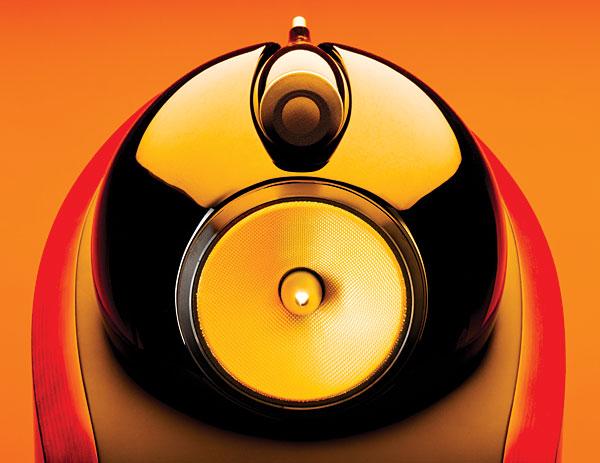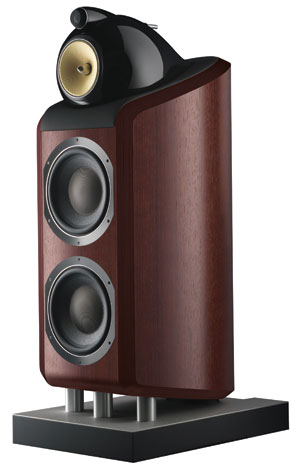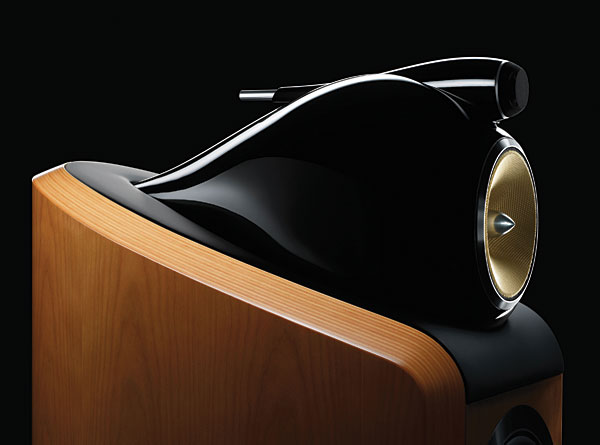B&W 800 Diamond
Original price was: R175,000.00.R130,000.00Current price is: R130,000.00.

As B&W’s 800 Series has evolved, Stereophile has reported on its progress. Lewis Lipnick reviewed the Matrix 801 Series 2 in 1987, and Wes Phillips wrote about the Nautilus 801 in 1999. I reviewed the B&W 800 Signature in 2002 and the 802D in 2005. This is getting to be a habit.In the years I’ve lived with the 802Ds, they’ve continued to provide wonderful musical experiences, and, like an old married couple, we’ve adapted to each other. I’ve adapted to their slight emphasis of the high frequencies and their upper-bass ripeness; they, in turn, have blended comfortably into my room’s décor. But recently B&W sent me a pair of 800 Diamonds, the flagship model of their new range, to challenge my resident 802Ds and the audio world at large.
The 800 Diamond doesn’t look radically different from its predecessors. Indeed, from the introduction, just before 2000, of B&W’s Nautilus series, with its distinctive midrange and tweeter enclosures of tapered Marlan, to the new Diamond series, any changes in appearance have been fewer and subtler than those seen in automobiles each year. However, B&W has advanced the technology with each series, and there is always something new under the hood. With the 800 Diamond, though, some of the visible changes are themselves functionally significant.
 First, the new grilles for the woofer and midrange cones are attached to the front panels by invisible magnets, as were only the tweeter grilles on the earlier series. While that provides for a clean appearance when the grilles aren’t in place, it also eliminates the need for any fussy swapping of the phase plugs on the Kevlar FST midrange driver. Previous 800s had a solid phase plug of shiny brass, but before affixing the grille it was necessary to unscrew this and replace it with a hollow plastic plug with a hole in its tip, which served to accept the grille’s mounting pin. Who wants to mess with that before receiving visitors, especially if they bring the kids?
First, the new grilles for the woofer and midrange cones are attached to the front panels by invisible magnets, as were only the tweeter grilles on the earlier series. While that provides for a clean appearance when the grilles aren’t in place, it also eliminates the need for any fussy swapping of the phase plugs on the Kevlar FST midrange driver. Previous 800s had a solid phase plug of shiny brass, but before affixing the grille it was necessary to unscrew this and replace it with a hollow plastic plug with a hole in its tip, which served to accept the grille’s mounting pin. Who wants to mess with that before receiving visitors, especially if they bring the kids?
Second, and more significant in terms of performance, the Rohacell woofers have smaller dustcaps, but their smaller size is a function of a B&W’s new “mushroom” diaphragm construction, which bonds the cone, dustcap, and voice-coil bobbin into a single unit rigid as a girder. B&W’s earlier Rohacell woofer cones had a huge central convexity that was part of the diaphragm’s design. A more potent electromagnetic engine drives the new woofers, powered by a motor system with two neodymium magnets to provide a more symmetrical magnetic field over long excursions, thereby reducing distortion and increasing dynamic response.
Third, B&W’s diamond tweeter has been reengineered. It has a new suspension, and four high-permeability magnets are used to reduce dynamic compression at high volumes.
Fourth and finally, the use of gold-silver-oil Mundorf capacitors in the HF crossover filter—like the diamond tweeter, once restricted to the earlier 800D—is now used throughout the 800 Diamond series, including the 805 bookshelf and the two Diamond center-channel models, the HTM2 and HTM4. This will contribute to more accurate timbral matching in multichannel arrays.
My review samples were finished in a superlative Gloss Piano Black accented with gold trim lines around each driver. The body of the 800 Diamond is supported above the substantial base by five sturdy pillars, three at the front and two at the rear. The space thus created and the matte silver finish of the base top and pillars create the illusion that the large main enclosure is floating in air. Thus, while the 800 Diamond is only an inch taller than the 802D, and while the 800 Diamond is larger and heavier than the black-based, rosewood-finished 802D, it doesn’t look it when placed next to the earlier model.
Set-up
The 800 Diamonds’ shipping cartons are huge—I was grateful for the assistance of Park Avenue Audio in unpacking and positioning the speakers. (Actually, I watched, they worked.) Shortly after they had made the cartons disappear, B&W’s Doug Henderson and Park Avenue’s Dennis Yetikel showed up to advise on the finer points of speaker setup. Henderson had brought along a favorite recording with very full, tight bass, with which he tried to optimize the 800s’ sound for maximum bass and without excessive bloom. He did that, but I think none of us was really satisfied—there was a lot of bass power, but with a bit of flab.
Not until I had at last been left alone with the 800 Diamonds did I discover that my Classé CT-SSP surround-sound processor was still configured with bass room-equalization settings for my resident 802D speakers, and that these filters were still in circuit. When I bypassed that EQ, the bass immediately became more taut and defined. (Henderson e-mailed me a copy of his test track and with a little tweaking, I could confirm that the bass was well-defined.)
Sound
But I’m getting ahead of myself. My first impression of the 800 Diamond was that it played much louder than the 802D, even though the two speakers’ claimed sensitivities are identical. It wasn’t long before I realized that the cause was a distinctively more smooth and balanced midrange that projected voices and melodies into the room. As a result, for a typical comfortable listening level, my preferred volume settings for the CT-SSP were 4–5dB lower than for the 802D. That’s significant in terms of amplifier power, and may go a long way toward mitigating the general observation that B&W’s past 800 models demanded gobs of power.
There’s another way to look at this phenomenon. Both the 802D and 800 Diamond could play at very high levels without distress, but I found I could play the 800 at much higher levels without evoking any listener stress. The 802D seemed to have a slight built-in “loudness compensation” that tipped up both the upper-bass and mid-treble; while that was warmly pleasant at normal listening levels, at much higher levels it sounded somewhat overwhelming. Strangely, the larger 800 Diamond had less artificial “authority” at all levels, while lacking nothing in terms of power, impact, bass extension, or weight.
Boccherini’s La Musica Notturna delle strade di Madrid, from the Stuttgart Chamber Orchestra’s Die Rohre—The Tube (SACD, Tacet S 074), which sounds so impressive through the 802Ds, was even better with the 800 Diamonds, with greater definition in the plucked and bowed strings. There was notably less resonance in the upper bass, which contributed to a more open soundstage as well as to specificity of instrument placement. The 800’s bass capabilities were both ample and tight, as revealed by the fourth movement of Mendelssohn’s Organ Sonata 1 in F, as performed by Thomas Murray (CD, Raven OAR-390): as the pedal notes descended, each shudder was not an ambiguous roar but had a clearly discernible pitch.

Bigger ensembles were magnificently portrayed by the 800 Diamonds. The last movement of Rachmaninoff’s Symphony 1 can seem, in some hands, to go on forever, but André Previn and the London Symphony whip it up real good in their classic recording from 1975 (CD, EMI 64530-2)—I really loved the snarling brasses, and oh, that bass drum had awesome weight. Even better was Prokofiev’s Symphony 5, with Dmitri Kitayenko conducting the GÅrzenich-Orchester Kîln (CD, Phoenix Edition 135). The two-channel sound through the 800 Diamonds was as powerful and spacious as these forces’ earlier set of Shostakovich’s symphonies (SACD/CD, Capriccio 71 029) was in multichannel! The large orchestra was presented as deep and wide, with brass that sparkled and sizzled, sweet upper strings, and weight from the lower strings and percussion. Inner detail illuminated the wind instruments.
If there was any fault to be found in the 800 Diamond, it was the revealing treble of that diamond tweeter. When the recording was a good one, like those mentioned, the highs had a preternatural purity that was simultaneously illuminating and sweet. This made listening to even older recordings of chamber music a delight—for example, the delicacy and coherence of Schubert’s Notturno, with members of the Beaux Arts Trio and pianist Menahem Pressler (CD, Philips 438 700), which is a bit brighter than the recent version from Christian Tetzlaff, Marie-Elisabeth Hecker, and pianist Martin Helmchen (SACD/CD, Pentatone PTC 5186 334). The older recording conveys a sense of time stopped, while the newer makes more of the passionate contrasts; the 800 Diamonds presented both with sweet, round string tone and no harshness or grain. However, with lesser source material, the 800 Diamond’s tweeter could reveal blemishes with clinical honesty. Digital music files streamed at low bit rates demanded a high-frequency filter, as did some high-definition downloads of remastered classic classical recordings. And love them as I do, I found that some Mercury Living Presence SACDs—eg, conductor Paul Paray’s collection of works by Chabrier (475 6183), and most of the Eastman-Rochester Symphony Orchestra discs, including those of Hanson’s symphonies (Mercury 475 6181)—had more sizzle and snap than was comfortable for me.
But most important, the 800 Diamond sounded absolutely devastating with really good recordings, particularly in its revelation of voices, both solo and in groups. I’ve pretty much given up on “audiophile preferred” recordings, but demos at the 2011 Consumer Electronics Show exposed me to many impressive examples. Thanks to Philip O’Hanlon of On a Higher Note, who gave me a CD-R copy of his “Demo Mix XIII,” it was easy to try some of these tracks with the 800s. Wow! In the Agnus dei from Ariel Ramirez’s Missa Criolla, conducted by José Luis Ocejo, tenor José Carreras’s voice simply floated in space, but with great warmth and presence, as the supporting voices and instruments were arrayed across the soundstage (CD, Philips 420 955 or First Impression Music LIMK2HD040). The voices of Shirley Horn (“Beautiful Love,” from You Won’t Forget Me, Verve 847 482-2) and Renée Fleming (singing Leonard Cohen’s “Hallelujah,” from her Dark Hope, Decca 80014186-2) were magically close and lush, and cushioned in a relaxed, spacious ambience. These recordings, of course, were selected for just these qualities, but if memory serves, none of the hotel-room demos I heard at CES could approach the delight of what two 800 Diamonds did in my living room. My taste in Ms. Fleming’s repertoire, however, veers to Richard Strauss and his devastatingly luscious valedictory, Four Last Songs (Renée Fleming, MÅnchner Philhamoniker/Christian Thielemann, Decca 478 0647). Here Ms. Fleming’s glorious soprano soared over the spacious carpet of Strauss’ orchestra and thrilled me more than Cohen’s wry “Hallelujah.” For any audiophile worth his salt, what could be more satisfying?
Comparisons
How did the 800 Diamond compare with other speakers that have graced my room in recent months? Without hearing them side by side, I must rely only on my notes to supplement my memory, but here goes. From the midrange down, the Canton Reference 3.2 DC that I reviewed in June 2010 seemed most similar in performance to the B&W, but while the Canton was a bit reticent with voices and throughout the upper midrange, the B&W was more transparent and open. The trade-off was that the Canton was more than forgiving of steely violins and the hashy HF of Web radio streamed at low bit rates, where the B&W was fairly ruthless.

As for B&W’s own 802D, see my comments above; in brief, the 800 Diamond was distinctly more even throughout the audioband. The 800 Diamond lacked the 802D’s generous warmth in the range around 100Hz and, yet, it had a stronger low end with decidedly more dynamic punch. This performance makes me wonder if JA will find the same “awkward combination” of low impedance and phase angles in the bass as he did with the 802D. As for the Revel Ultima2 Studio (reviewed in March 2008), memory won’t permit me to say much more than that I recall it sounding as open and balanced as the 800D, but with a bit less focus in the extreme HF. Hie thee to an audio salon and compare them for yourself.

Conclusions
Bowers & Wilkins’ 800 Diamond was, overall, simply a pleasure to listen to. B&W continues to improve the underlying technology of its 800 series speakers and the result is apparent in the 800 Diamond’s sound. Its overall honesty, attested to by the 800 series’ heritage as studio monitors, lets the 800 Diamond get the most information out of all recordings without, as far as I could tell, any practical limitation in dynamic range. Better yet, the 800 offered the same balanced sound at all listening levels, and the pair of them threw a remarkably huge and detailed soundstage. And surprisingly for such large, elegant-looking speakers, they seem to disappear from your awareness to leave the listener alone with just the music.
Review
Bowers & Wilkins’ 800 Diamond was, overall, simply a pleasure to listen to. B&W continues to improve the underlying technology of its 800 series speakers and the result is apparent in the 800 Diamond’s sound. Its overall honesty, attested to by the 800 series’ heritage as studio monitors, lets the 800 Diamond get the most information out of all recordings without, as far as I could tell, any practical limitation in dynamic range. Better yet, the 800 offered the same balanced sound at all listening levels, and the pair of them threw a remarkably huge and detailed soundstage. And surprisingly for such large, elegant-looking speakers, they seem to disappear from your awareness to leave the listener alone with just the music.
Description
Specifications
Three-way, vented-box, floorstanding loudspeaker.
Drive-units: 1″ (25mm) diamond-dome tweeter, 6″ (160mm) woven-Kevlar FST-cone midrange unit, two 10″ (250mm) Rohacell-cone woofers.
Crossover frequencies: 350Hz, 4kHz.
Manufacturer’s specifications:
Frequency range: –6dB at 25Hz and 33kHz.
Frequency response: 32Hz–28kHz, ±3dB on reference axis.
Dispersion: within 2dB of on-axis response over 60° (horizontal) and 10° (vertical) arcs.
Sensitivity: 90dB SPL (2.83V/m).
Harmonic distortion (second and third harmonics, 90dB, 1m): <1.0%, 45Hz–100kHz; <0.5%, 80Hz–100kHz.
Impedance: 8 ohms nominal, 3.1 ohms minimum.
Recommended amplification: 50–1000W into 8 ohms with unclipped program.
Maximum recommended cable impedance: 0.1 ohm.
Dimensions: 46.5″ (1180mm) H by 17.7″ (450mm) W by 25.4″ (645mm) D. Weight: 225 lbs (102kg).













Reviews
There are no reviews yet.